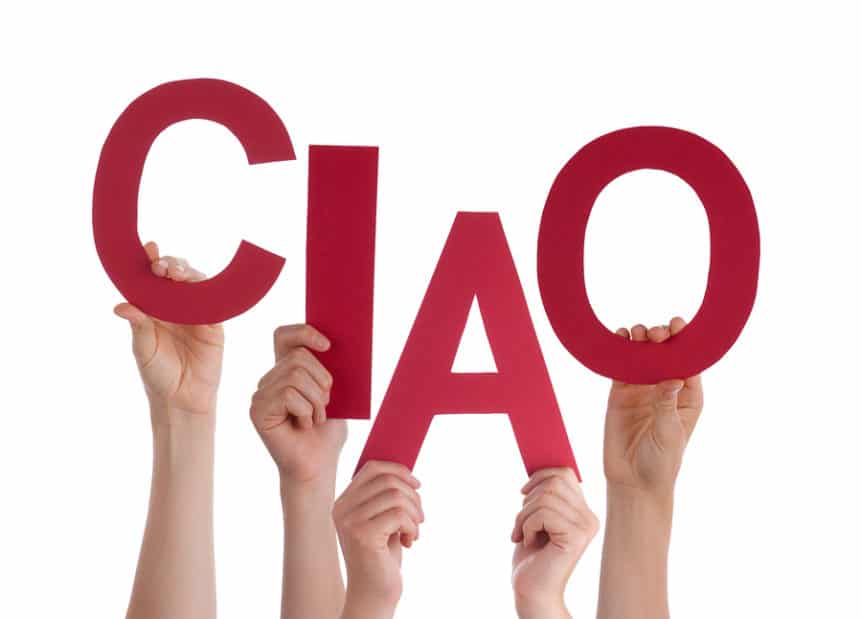This article originally appeared in the February 2015 issue of Dream of Italy. Updated 2018.
There are few people who know more about the ins and outs of Italian life, than our friend Ann Reavis, a phenomenal tour guide in Florence, and the author of Italian Food Rules and Italian Life Rules, from which this article is excerpted. These two ebooks are musts for anyone traveling to Italy – even if you have been a dozen times, I promise you that you will learn something new.
Now, some advice from Italian Life Rules – when to say ciao. Here is Ann’s excellent advice:
To Ciao or not to Ciao
Heard in Rome: “Ciao, Beppe! Is this your mother? Buonasera, Signora Orsini.”
Who would have thought using an ubiquitous Italian word in Italy could get you into so much trouble? The word is “ciao” and if you use it at the wrong time with the wrong person you will leave a lasting negative impression.
Ciao is described as the Italian version of “aloha,” meaning both “hello” and “goodbye,” so how can that be bad? As with many things in Italy, it all comes down to history.
Ciao comes from Venetian dialect, where the phrase s-ciào vostro meant “I am your slave.” Often, s-ciào vostro was shortened to simply s-ciào and then to ciào. In Latin, the word is sclavus and in standard Italian schiavo, which is where the Venetian s-ciào is derived.
In the 17th century, the term was used by servants when encountering their employer: “I am your slave.” This transformed into “I am your servant,” used by a person of inferior social status to one of greater importance and finally, to “I’m at your service” when addressing a stranger of one’s own age or older. It was never used as a casual greeting before the 20th century.
In modern Italy, ciao is mainly used in informal settings, i.e., among family members, relatives, and friends. In other words, with those one would address with the familiar tu (second person singular) as opposed to Lei (courtesy form). With family and friends, ciao is the norm even as a morning or evening salutation, in lieu of buongiorno or buonasera. When used in other contexts, ciao may be interpreted as slightly flirtatious, or a request for friendship or closeness. Or it may seem to the recipient as an ill-bred form of address.
Some say that Ernest Hemingway introduced the word ciao to the American lexicon in 1929 in his book Farewell to Arms with its Italian setting. Others say it traveled outside of Italy with waves of immigrants after WWI and WWII. Now, it is used throughout the globe as a salutation a greeting, both in writing and speech.
In Italy, however, it is still a very informal greeting. To use it with a stranger or an elder is an easy and unknowing way to offend. It is much better to get into practice before you arrive with the proper mode of greeting an Italian and then the salutation to be used when parting company. This is also important when saying goodbye when you are talking on the telephone with a stranger. Never say, “Ciao.”
When you are introduced or encounter a stranger, use the words buongiorno (good day) or buonasera (good evening), depending on the time of day (buongiorno before 1pm and buonasera after 1pm). These will become your favorite words because they will never offend and they can be used as both greetings or parting words. If you want to up your game a bit then piacere (my pleasure) is a good formal greeting (but never used for parting ways).
Finally, if you would like to split the difference, salve is a great greeting for a stranger or a friend, of your age or younger. Salve comes from the Latin verb salvere (literally, to be well, to be in good health). It can be very friendly, e.g., Salve! Come va? (literally, Hi! How’s it going?), but on its own it’s also a polite form of greeting without being too formal.
When parting company, the safest word to use is arrivederci. Like salve it can be used with strangers.
Americans have become famous for their “Have a nice day!” parting exclamation. Italians use “buona giornata” ([have a] good day) less frequently, but it is gaining popularity and can be used with most everyone except the most formal of folks. It is always used as a parting. Buona serata ([have a] good evening) is similar, but used usually when parting with someone who is going off to do something fun, for example, an evening at the theater, disco, or cinema.
Does this mean you can never say “ciao?” No, you will hear ciao being said all over Italy. But if you pay close attention, you’ll see that it’s almost always used between people who know one another or are in the same peer group. — Ann Reavis

